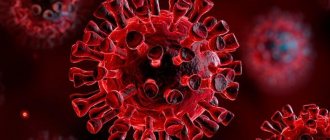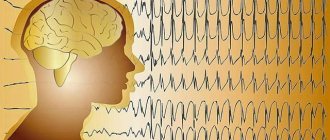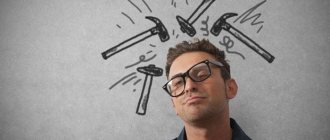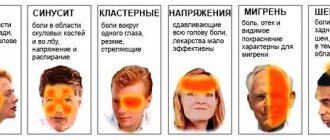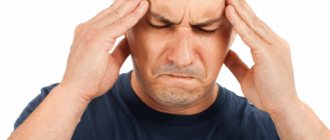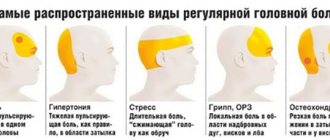Residents of modern cities increasingly complain of prolonged pain in the head. At the same time, the majority of the population does not think about why they have headaches every day. In this case, it is enough to drink aspirin or mint tea.
Meanwhile, in an absolutely healthy part of the population, headaches do not occur under any circumstances. Next, let's look at why I have a constant headache.
Where should I start?
Unfortunately, most patients who have headaches every day resort to the most incorrect tactics. They self-medicate. They use painkillers without a doctor's prescription or examination. This is completely unacceptable for the following reasons:
- This therapy is completely ineffective. After all, different methods and medications will bring relief for different types of headaches.
- Medicines that relieve this discomfort have many side effects. The drug, which is used quite often, can cause serious damage to the body. The consequences of such unjustified decisions can be very serious.
- To protect yourself from sudden headaches, you need to understand the cause of the discomfort. And you need to fight not with the symptoms, but with the disease.
Therefore, treatment should begin by asking the question: “Why does my head hurt?” And to answer it, you need to visit a doctor. He will send the patient for examination. Indeed, under this symptomatology there may be diseases of the spinal column, inflammatory processes affecting the meninges, malignant neoplasms, pathologies affecting the vessels of the head and the circulatory system.
Causes of pain
Doctors identify several sources that in most cases provoke headaches:
- migraine;
- nervous tension, constant stress;
- strong physical activity;
- pathologies of cerebral vessels (the cause that provokes headaches in the weather-sensitive population);
- low or high blood pressure;
- pathologies of the pancreas and kidneys;
- cervical osteochondrosis;
- diseases of the ENT organs;
- intoxication and poisoning of the body;
- skull injuries;
- changes in hormonal levels (pregnancy).
Let's look at the most common causes of headaches.
Neoplasms in the brain
Any tumors in the brain lead to headaches for a long time, for example, a month.
Tumors are almost always accompanied by pain. At the beginning, the pain may not be severe, becoming more noticeable by the end of the day. Parasitic cysts also lead to unpleasant symptoms. To identify them, timely and high-quality diagnostics are needed, which will be referred by a specialist.
If you have a headache for a month, the cause may be inflammatory diseases . In most cases it is encephalitis or meningitis. The pain is characterized not only by duration, but also by strong intensity. Analgesics will not help in such a situation, which can make treatment very difficult.
The pain may last a week or longer due to the constant use of painkillers. In such a situation, a secondary syndrome is identified. Headaches of low and moderate intensity, however, differ in frequency. Sometimes a person awakens with the appearance of unpleasant sensations. This situation can develop into chronic cephalalgia, which is difficult to treat. On average, after stopping the medication, the pain syndrome should disappear over time.
Tormenting migraine
This is a primary headache, therefore we are talking about a disease.
Characteristic symptoms of the pathology are:
- headache every day for several days;
- attacks may recur monthly;
- the discomfort is pulsating;
- the pain manifests itself in one half, but can cover the entire head;
- discomfort often occurs in the morning;
- vomiting is sometimes observed;
- the patient cannot tolerate noise and light.
Until today, doctors have not figured out what causes migraines. There is an assumption that the pathology develops as a result of hormonal imbalances, stress, diets, insomnia, bright light, smell or a hereditary factor.
Tension pain
Unfortunately, in the modern world this is a fairly common cause of discomfort. It may be based on emotional or muscle tension. And as a result, my head hurts every day. Emotional tension is provoked by strong arousal, stress, and depression. Muscle discomfort includes excessive overload of the neck tissues.
As a rule, a person experiences a severe headache for several hours in a row. It is oppressive, dull in nature and in most cases covers the entire head. Sometimes the discomfort is short-term, but it occurs often.
Cervical osteochondrosis
With this pathology, the back of the head often hurts. Sometimes this is the only complaint the patient has. We are talking about secondary pain because it occurs as a result of a disease.
Compression and swelling of the spinal nerves provokes unpleasant discomfort, which is often found in the occipital part. However, some patients experience headaches in their temples. Typical symptoms of this disease:
- constant headache;
- an attack can last up to 10 hours;
- sudden movements increase discomfort;
- presence of nausea;
- vomiting does not bring relief;
- insignificant increase in temperature;
- The discomfort is increasing.
Sometimes, as a result of osteochondrosis, diencephalic syndrome can develop. Blood circulation in some areas of the brain is impaired. The patient's blood pressure rises, sweating increases, and the skin turns pale.
Arterial hypertension
This pathology is almost always associated with the fact that the patient has a headache. The pressure rises and provokes similar unpleasant symptoms. It should be noted that advanced hypertension is fraught with serious consequences: stroke, vascular dementia.
As soon as the pressure returns to normal, the headache immediately goes away. But sometimes the discomfort lasts for several days even with stable pressure.
In some cases, pain is caused by adrenal tumors. The patient has:
- high blood pressure;
- sweating;
- attacks of nausea;
- tremor of fingers.
The patient needs to check the functioning of the endocrine system, since treatment of hypertension will not reduce high blood pressure.
Is it possible to get rid of headaches without medications using home remedies?
Yes, but not always. For example, against migraine (unilateral pain, often in the eye area or behind the eye, pulsating, gradually increases and lasts from 4 to 72 hours), there are no “folk” remedies. An adequate course of drug treatment is necessary.
If the headache is caused by increased blood pressure, then you need to take a blood pressure lowering drug (not a painkiller). If you have a headache, you should first measure your blood pressure before taking pills for pain.
But headaches associated with overexertion can be relieved with non-drug methods. Often the head starts to hurt due to improper posture. For example, a person works at a computer for a long time, sits in the wrong position: his shoulders are raised, his head is moved slightly forward. As a result, the neck muscles become overstrained and produce a characteristic nagging headache, not very strong, but debilitating. In this case, simple exercises to stretch the neck muscles and massage help a lot. You can even just get up from your desk, move around, and the pain will go away.
Often a headache occurs towards the end of the work week. Especially if you have a busy schedule and the person did not get enough sleep, did not eat very well, etc. In this case, you need to first of all get enough sleep (healthy sleep is extremely important for a person with a headache). You can take a hot bath, if there is no high blood pressure, drink green tea, and take a walk in the fresh air. In general, if it is possible not to take pills, it is better not to do so.
It squeezed my head like a helmet. Why does my head hurt, but the disease is not found? More details
Intracranial pressure
Such disturbances quite easily provoke headaches. In this case, the underlying cause may be either high or low blood pressure. Without a doctor it is extremely difficult to determine this pathology.
Unfortunately, in most cases the patient takes analgesics because he has a headache. The causes of pressure disturbances can be very serious - brain tumors, intracranial hematomas. In this case, it is important to pay attention to the symptoms accompanying the headache:
- presence of dizziness;
- drowsiness;
- periodic vomiting.
Intracranial pressure changes not only as a result of serious pathologies. Quite often, an increase is diagnosed in obese people.
This pathology signals itself with the following signs:
- the back of the head hurts, sometimes there is discomfort in the temples and forehead;
- weather changes make the situation worse;
- after overwork or stress, the patient experiences more severe discomfort.
Is it possible to endure a headache and do without pills?
If a headache interferes with your work responsibilities or household chores, then you don’t need to endure it, you should take a painkiller. However, there are situations when even with a seemingly ordinary headache, it is necessary to consult a doctor, and not try to relieve it with analgesics yourself.
There are four criteria for a dangerous headache, accepted by leading experts around the world. Everyone needs to know them.
1. Did your headache first appear after you were 50 years old? This is most often a sign of a serious illness.
2. Did your head hurt suddenly and very badly? Such pain may be a symptom of intracerebral hemorrhage.
3. Does the headache gradually increase, become stronger, and last for several days or even weeks? This is how the first attack of migraine, the development of a tumor or an infectious process in the brain (meningitis, encephalitis, etc.) may manifest itself. The infection may be accompanied by symptoms of general malaise, in particular high fever and weakness. But sometimes there is only one symptom: headache.
4. Is the headache accompanied by nausea or impaired consciousness (fainting, confusion, the person seems to be inhibited, loses orientation, etc.) or is it significantly worsened by coughing and sneezing? This condition indicates that there is increased intracranial pressure. The cause may be a tumor or problems with the cerebrospinal fluid that washes the brain (impaired circulation, increased or decreased production, etc.).
Any of the listed symptoms indicates that you need to consult a specialist.
Types and possible causes of headaches. Infographics Read more
Pain caused by atherosclerosis
Elevated cholesterol levels often lead to the development of serious pathologies. Atherosclerotic plaques form in the vessels of the brain. They narrow the lumen of arteries and veins. The blood flow is not able to circulate freely. The brain begins to experience a deficiency of nutrients and oxygen. As a result of atherosclerosis, constant headache appears.
Associated symptoms may include:
- irritability;
- insomnia;
- decreased performance;
- memory impairment.
With atherosclerosis, the patient complains that the head hurts in the temples, frontal part or occipital part. Doctors state that discomfort can appear in any area.
Only the fight against atherosclerosis will eliminate unpleasant symptoms.
Basic treatment methods
After undergoing an examination and collecting an anamnesis, the doctor will prescribe the necessary treatment. It is necessary to strictly adhere to the doctor's instructions. Treatment will last at least ten days. Consist of a set of measures that cannot be neglected at your discretion.
Complex of therapeutic measures:
- if the cervical spine is unstable, you will need to wear a collar every day, the timing of its wearing will be determined by the doctor;
- physical therapy, it is better if the exercises are performed several times a day;
- acupuncture;
- cranial osteopathy;
- massage;
- physical procedures;
- manual therapy;
- compresses, ointments applied two or three times a day.
The use of medications is mandatory: antidepressants, non-steroidal anti-inflammatory drugs, muscle relaxants. Taken orally or injected intramuscularly every day.
Additionally, you will need to follow a diet, eat right, avoid stress, get proper rest, and maintain a daily routine.
Interesting: Dizzy and headache after chemotherapy: what to do?
After completing the course of treatment, you can use our tips on how to prevent or quickly relieve headaches.



